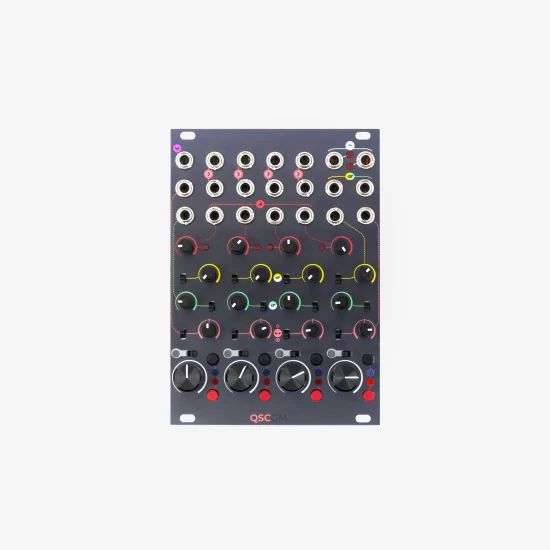Fumana
FUMANA
Dual 16 Bands Spectral Editor
fumana / fuˈma:na / s.f. [dialect of Modena, from Latin fūmus, ‘smoke’] – ‘fog’. Like specters use to lie into the thick fog (which the Modenese countryside is pretty rich of), so many spectral capabilities and functions do within the thick bands of the ‘fumana’.
OR:
850,00 € + VAT
Out of stock
Want to be notified when this product is back in stock?
Description
FUMANA is a dual all-analog fixed filter bank. Each filter bank is composed of an array of 16 independent bandpass filters tuned to specific frequencies.
We designed FUMANA around one basic core principle: modify the spectral content of the incoming audio signal by filtering it through 16 bandpass filters in parallel and then vary the amplitude of each resulting band.
Even though this core principle is relatively simple, the key feature of FUMANA is that it provides a wide set of controls over the bands’ amplitude: the spectral content of the incoming sound can be thus modified by the faders, which are individually CV-controllable; by the envelope followers which are generated by the analysis of the sound patched in the Modulation input; by the global parametric controls such as Tilt and Scan.
Furthermore, a flexible input/output signal routing allows the musician to “split” the 16 filters into two 8-band spectral processors by grouping the odd and even bands separately. It will be possible to process two independent signals, or to blend two signals into one output, or even to perform two different sonic treatments over the same signal and route it to two different output sections.
Individual outputs are available for each band, both for the Main sound (i.e. the filtered one) and for the Mod sound (i.e. the resulting envelopes).
Since a spectral transfer tool may be used as a “vocoder-like-effect”, the FUMANA provides an input for an external noise which may be used for fricative/sibilant sounds.
Key Features
FUMANA has two arrays of sixteen bandpass filters each. The first one, with 48 dB/oct filters, provides a colorful tool for processing your sound.
The second one, with 36 dB/oct filters, analyzes a sound and extracts sixteen envelopes for spectral transferring.
You can sculpt your sound through the sixteen faders and voltage-control them individually.
Then, you can further animate the timbre through four voltage-controlled functions: Tilt, Peak/Notch, Center, and Width.
Two semi-normalled inputs allow you to use FUMANA as a single sixteen-band or two eight-band spectral editors.
The division is between Odd and Even bands so that you can:
- Process two different sounds in the Odd and Even bands and merge them to a single All output;
- Process a single sound and route its Odd and Even bands to two different points of your patch (like for stereo spread);
- Process two separate sounds with independent routing.
A parallel array of sixteen bandpass filters allows you to perform spectral transferring or vocoding over all the sixteen bands.
You can even use two different sounds for the Odd and Even Bands, performing two eight-band vocoding operations at the same time!
You can independently control the attack and release time of the spectral transferring and also access the individual bands’ envelope followers.
Such outputs allow you to manually re-route the analysis bands to the synthesis ones, just like in classic analog vocoders.
A global Envelope Follower Output is available for external ducking or other parallel processing.
Learn
Learn
Learn
Additional information
| Weight | 0,77 kg |
|---|---|
| Dimensions | 15,6 × 23,6 × 6 cm |
| SIZE | 18 HP |
Specs
Size | 42 HP |
Depth | 38 mm |
Current draw | 430 mA @ +12 V 390 mA @ -12 V |
CV input impedance | >90 KΩ |
CV output impedance | <50 Ω |
Audio input impedance | >20 KΩ |
Audio output impedance (main) | <50 Ω |
Audio output impedance (individual filters) | <250 Ω |
Envelope followers amplitude from 0-10 V (1) | ±5 % |
More details on the Manualone.
FAQ
A. Use
Our modules are packed with high-quality components that demand a proper power supply and can get sensibly warm.
That is its normal temperature and we can guarantee their performance.
The MOD inputs route an external signal to an array of 16 filters at the same frequencies of the main filter array that shapes the sounds you patch to the MAIN input.
However, the product of these 16 modulation filters is not audible, since their purpose is to generate as many envelopes according to the intensity of the signal passing through each band. The envelopes then control the amplitude of the main 16 bands. This function is often referred to as ‘spectral transferring.’
If you patch an LFO to the modulation inputs you will not hear anything, since its frequency will be below the cutoff of the lowest filter.
If you patch a sawtooth or a square LFO, however, FUMANA will detect the transients, thus providing interesting, snappy sounds.










